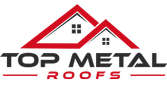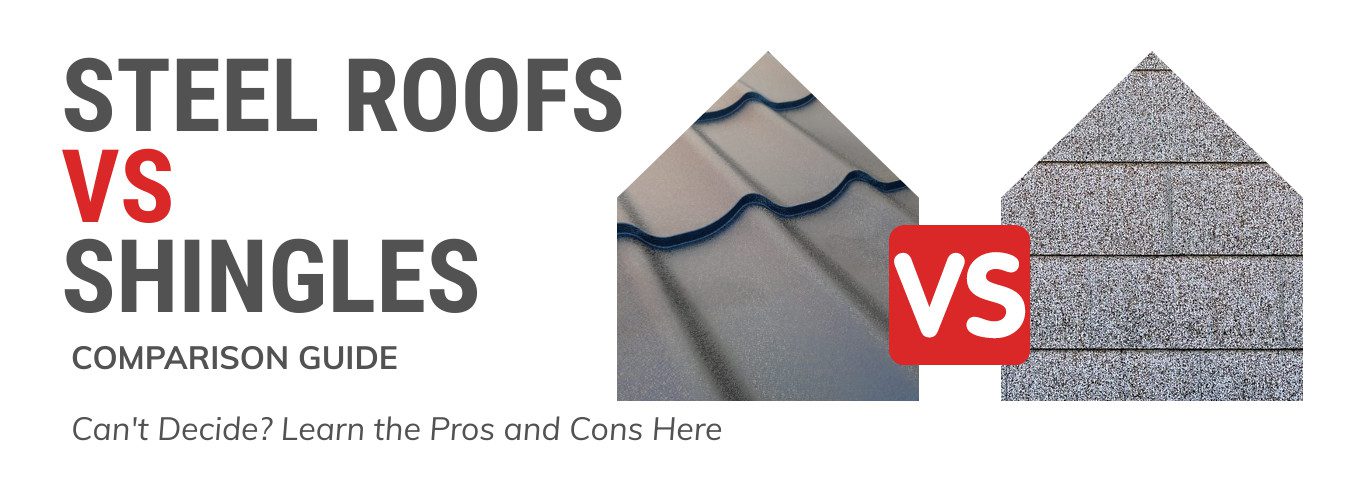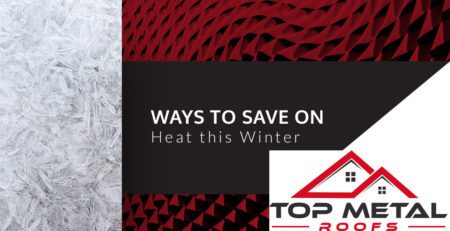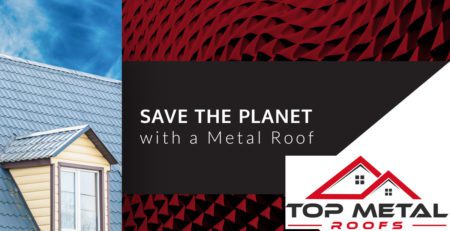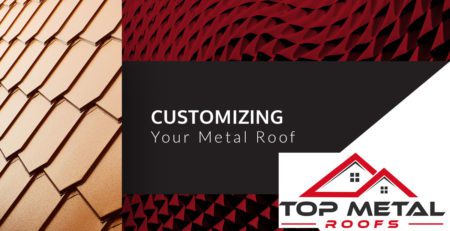Steel Roof vs Shingles: A Comparison Guide
Steel roofs vs Shingles: wondering which option you should consider? The following breakdown will help you make an informed decision about which of these 2 popular roofing choices will be best for you.
Both asphalt shingle and metal roofs are viable options for anyone embarking on a roofing project. Other options include clay tile, wood roofing, slate and composite materials. For the majority of people searching for roofing materials, weighing all the advantages and disadvantages of each roofing option can be overwhelming. In this article, we’ll talk about: 1) the advantages and disadvantages of metal roofing, and 2) the advantages and disadvantages of asphalt shingles.
Cost of Steel Roofs vs Shingles
A steel roof designed for residential use is approximately 2 times the initial cost of shingles. Most shingle roofs last a maximum of 15 years in Ontario due to our harsh weather conditions. A quality steel roof will be guaranteed for 40-50 years. In other words a steel roof costs 2 times more but lasts at least 3 times longer. Another consideration is the cost of inflation. A shingle roof that costs $10 000 today will cost about $20 000 in 15 years from now. Most homeowners that opt for a steel roof will never need to worry about re-roofing again, so inflation costs are a non-issue.
Steel Roofing
Steel roofing is usually a more complex option since it requires experienced installers, unique expertise, and additional parts and pieces. Moreover, steel roofs are increasingly becoming dominant, especially in environments that experience extreme weather conditions. Besides the fact that steel roofs can last decades longer than asphalt shingles, they provide versatility and more options than the majority of the traditional roofing materials. The following are the detailed pros and cons associated with steel roofing material.
Advantages of Steel Roofs
- Weathering performance: In comparison with asphalt shingles, steel roofs are the most durable and strongest, especially in extreme weather conditions. A properly installed steel roof can withstand extreme cold, snow, strong winds, high heat, and hail alongside ice.
- Environmental friendly: Steel is the most eco-friendly roofing option as it is highly recyclable since leftover pieces can later be reused. Moreover, steel sheets can be manufactured from previously recycled materials.
- Energy efficiency: Most steel roof manufacturers are currently producing highly emissive metal panels with the capacity to release heat during high temperatures. Moreover, it is easy to mount energy-saving devices such as solar panels on steel roofs using clamps.
- Low maintenance: When correctly installed, the maintenance cost of steel roofs is usually low. The majority of steel roof manufacturers provide guidelines on how to care and maintain new roofs, including getting rid of debris, branches, leaves, and other wastes blown onto the roofs and gutters by intense storms.
- Fire resistance: Steel roofs are usually class-A rated in terms of non-combustibility, thus making them the most fire-resistant roofing materials. Fire-resistance is particularly essential in areas with high risks of wildfire outbreaks.
- Increase in the property value: A Property constructed using steel roofs has a higher value than those roofed using shingles. Typically, a steel roofed house is estimated to be 1-6% higher in value than shingle roofed houses. Moreover, the steel-roofed property is easier to resell, especially if the roof is in perfect condition since it is one of the factors home buyers consider when making purchasing decisions.
- Increased colour options: steel roofs come in any colour. Steel roof manufacturers have partnered with reputable paint makers with the ability to make high-quality paints that last for decades.
- Economical in the long-term: Though steel roofing is more expensive as a one-time project, it is typically cheaper than shingle roofing in the long-run. Given than one steel roof can last 50+ years, it can outlive approximately three shingle roofs with a lifespan of 15-20 years each. For instance, shingle roofing costs approximately $8,700, while the cost of one steel roofing with high-end paint is about $17,400. Therefore, it would cost $26,100 to use shingle roofs (8,700 x 3= $26,100) within 60 years, while the steel roof would cost $17,400 during the same period. Therefore, steel roofs are more economical than shingles in the long-term.
- Longevity: Steel roofs can last for at least five decades before developing signs of destruction. Durability is the primary advantage of steel roofs over shingles. When various materials such as zinc and copper are incorporated in manufacturing metal roofs, they can last up to 100 years or more.
- Lightweight: Steel roofs are lightweight compared to asphalt shingles. Therefore, they are easier transport and handle when installing. More importantly, steel roofs do not exert unnecessary pressure on a building, which preserves the building integrity by reducing frame damage.
Disadvantages of Steel Roofs
- The limited number of qualified contractors: It is difficult to find experienced and qualified steel roof installers or contractors. Steel roof installation requires a high degree of accuracy, and few installers are qualified or skilled to perform this complex roofing process.
- Installation is labor-intensive: Steel roofs require attaching metal panels to the deck using screws and connecting the panels. Moreover, metal roofs require the installation of flashing, which requires multiple pieces of metal. All these activities require a lot of skills, labor, and time.
- High initial installation cost: As a one-time cost, metal roofing is more expensive than shingle roofs. Additionally, the labor cost and other equipment required to complete steel roof installation are higher than shingle installation.
Shingle Roofing
Over the last century, shingle roofs were the most common roofing materials for most people building residential and business properties. Without a doubt, shingle roofs have several benefits ranging from low upfront costs to the ease of installation and material accessibility. The detailed advantages and disadvantages of roof shingles are discussed below.
Advantages of Shingle Roofing
- Easy installation and replacement: replacing and installing shingles requires less labor and time compared to steel roofs. Shingles are usually prepackaged from the manufacturer, hence easy to nail them to the deck unless where cuts are necessary.
- Cheap to repair: Since the cost of installing and replacement is low, repairs are also relatively low. The damaged shingle can easily be moved while a repair is being done. However, steel roofing is a complex process as full-length panels have to be moved since they are all connected.
- Higher Warranty: shingle roofs come with a higher warranty offers from both contractors and manufacturers. Examples of popular shingle warranties include material defect, algae growth, manufacturer error, contractor error, and maximum wind-resistance limit.
- Readily available: Shingles are readily available from local retailers and distributors.
- Coast-friendly: Though shingles and steel roofing can be installed in coastal areas, the warrant for the latter is determined by the distance from the coast due to the ease of destruction by strong winds. However, shingles, particularly asphalt, are heavier thus, not prone to destruction by strong coastal winds.
- Foot traffic: It is easier to walk on shingle roofs for installers compared to steel roofs. Steel roofs get easily dented, buckled, and scuffed under pressure.
- High number installers: there is a relatively higher number of shingle installers due to the ease of installing compared to steel installers
- Economical in the short-term: Shingles are cheaper to buy and install than steel roofs, hence the reason they are still preferred by homeowners. For instance, it costs $2,100-4,800 to install organic asphalt shingles in a 1,500 square feet home, while installing a steel roof costs $7,500-15,000 for similar home size.
Disadvantages of Shingle Roofing
- Expensive in the long-term: Though shingle roofing is cheaper as a one-time cost, the long-term cost of replacing them ends up being higher than metal roofing.
- Short lifecycle: Most shingle roofs cannot last beyond 15 years. Therefore, second-layer additions and replacements are common with shingles.
- Colour limitations: in most cases, shingle roofs are dull in colour. Using bright light-coloured paints such as those used on steel roofs is impossible with shingles due to their asphalt-saturated base materials and dark granite material of the granules added for fire resistance and protection.
- Bulky: Asphalt shingles are heavy despite the numerous attempts to minimize their weights in recent years. Such a weight can exert pressure on the building and lead to architectural problems in the long-run.
- Fire issues: Though most shingles manufactured nowadays are class A-rated, they contain asphalt, which is a semi-solid combustible petroleum product. The asphalt coating using granules is what makes them class-A fire-resistant, but this is only on the surface as fire flames may reach the asphalt coating, which is combustible.
- Easily damaged: shingles, particularly the 3-tab shingles, get easily damaged compared to steel roofs. Such shingles easily get damaged during extreme weather conditions such as snow, hail, and wind. Moreover, shingles rip off or lift up, especially when adhesive is incorrectly applied.
- Energy inefficiency: Shingles can absorb a lot of heat rays and warmth from the sun due to their dark colours. Such heat is retained within the shingles, which may subsequently get transmitted to the building as solar heat. Consequently, this may necessitate the use of air conditioners to balance room temperatures, which could be costly. Moreover, asphalt shingles quickly get damaged when exposed to prolonged heating.
- Oil-based materials: Oil, a petroleum product, is a primary ingredient of shingles. Therefore, the cost of shingles is likely to be affected by oil prices. Moreover, oil products are usually non-recyclable.
- Mould, mildew, and algae: Shingles are prone to Algae, mould, and mildew growth, especially if the roof is exposed to excess moisture or lack of enough heat from the sun. Such growths resemble unappealing dark or green coating on parts of the roof, and this reduces the aesthetic value of the house.
Depending on how long you plan to stay in your current home, you should be able to use the information from this article to choose the best option for your next roof.
